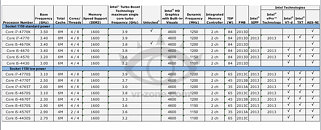Tuesday, December 11th 2012

Intel Core "Haswell" Quad-Core Desktop CPU Lineup Detailed
2013 promises to be another year, with another new line of processors by Intel, and like every alternate year, the company will introduce a new client desktop CPU socket. With its 4th generation Core "Haswell" processor family, Intel will introduce a brand new CPU architecture that steps up IPC over current Core "Ivy Bridge," hence, Intel's Core desktop processor lineup will not ship with higher clock speeds, yet higher performance. The new chips will be built in the LGA1150 package, and will be accompanied by Intel's 8-series "Lynx Point" chipset.
By Q2-2013, Intel will have launched as many as 14 Core desktop CPU models, including six in the mainline, and eight power-optimized ones. Its nomenclature is somewhat similar to that of current Core "Ivy Bridge" lineup, except the 4000-series numbering. Leading the pack is the Core i7-4770K (unlocked) and i7-4770, clocked at 3.50 GHz with 3.90 GHz Turbo Boost, featuring eight threads with HyperThreading, 8 MB of L3 cache, Intel HD Graphics 4600 iGPU clocked up to 1250 MHz, with 84W TDP; followed by Core i5-4670K (unlocked) and i5-4670 clocked at 3.40 GHz with 3.80 GHz Turbo Boost, and 6 MB L3 cache. The Core i5-4570 and i5-4430 are clocked at 3.20 GHz (3.60 GHz Turbo) and 3.00 GHz (3.20 Turbo).Intel's mainline Core desktop processor lineup is overshadowed by as many as eight energy-efficient processor models. The Core i7/i5 "S" series reduce TDP to 65W while maintaining clock speeds, while Core i7/i5 "T" series reduce TDP to 45W, with a little help from lower clock speeds.
Source:
VR-Zone
By Q2-2013, Intel will have launched as many as 14 Core desktop CPU models, including six in the mainline, and eight power-optimized ones. Its nomenclature is somewhat similar to that of current Core "Ivy Bridge" lineup, except the 4000-series numbering. Leading the pack is the Core i7-4770K (unlocked) and i7-4770, clocked at 3.50 GHz with 3.90 GHz Turbo Boost, featuring eight threads with HyperThreading, 8 MB of L3 cache, Intel HD Graphics 4600 iGPU clocked up to 1250 MHz, with 84W TDP; followed by Core i5-4670K (unlocked) and i5-4670 clocked at 3.40 GHz with 3.80 GHz Turbo Boost, and 6 MB L3 cache. The Core i5-4570 and i5-4430 are clocked at 3.20 GHz (3.60 GHz Turbo) and 3.00 GHz (3.20 Turbo).Intel's mainline Core desktop processor lineup is overshadowed by as many as eight energy-efficient processor models. The Core i7/i5 "S" series reduce TDP to 65W while maintaining clock speeds, while Core i7/i5 "T" series reduce TDP to 45W, with a little help from lower clock speeds.

64 Comments on Intel Core "Haswell" Quad-Core Desktop CPU Lineup Detailed
Back in my day, only had to remember one set of specs per CPU family and the only variable was the Mhz/Ghz of each model. Now there's exceptions all over the place and some of my most visited links are the CPU lists at Wikipedia and ark.intel.com.
I do agree that if there was a bit of competition on the higher end we could've had lower prices / more cores.
Also mainstream needs 6 cores so the HEDT platform gets more than 6 stagnant cores we've been having since Gulftown.
And yes, Sandy Bridge-E is a totally different beast. Every processor can be overclocked on that platform due to the way the platform is designed. That doesn't mean everyone overclocks that use it.
And don't confuse the Extreme edition processor with K series processors. The Extreme Edition processor offer more than just an unlocked multiplier. Professionals do use those processors and don't overclock them. There is no locked equivalent to the 3970X, it is just a flat out bad ass processor. However, there are locked equivalents to the K series processors. There is a 3770 that matches the 3770K, the K is unlocked and the non-K has VT-d.Read my post, the K processors do have VT.
And exactly how far back is "your day"? I mean even going back to 80386 different models had different sets of specs.
Edit: I also like the 35W desktop quad cores.
I was only pointing out that the LGA2011 platform has processors that can OC and have VT-d (3970X, 3960X, 3930K and 3820). The “K” nomenclature is peppered in there as you know. As far as I know all the Sandy Brdige-E processors C2 stepping and above have functional VT-d support in hardware with OC support and that includes the Core i7 3930K.
There aren’t that many “K” processors to begin with. Considering only the most current processor line available (Ivy Bridge and Sandy Bridge-E) the percentage of K processors that support VT-d is 33.3% or 1/3 (out of the 3930K, 3770K and 3570K). If you consider OCable processors as a metric all the Sandy Bridge-E processors can OC so the percentage there (with Ivy Bridge) with respect to VT-d support would be 60% with VT-d support.
The value of OC + VT-d is up to the individual. I agree that most people who want one of these features doesn’t necessarily care about the other.
when intel release something news or rumor on their upcoming processor line up, i'm just laughing :laugh: